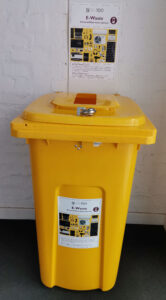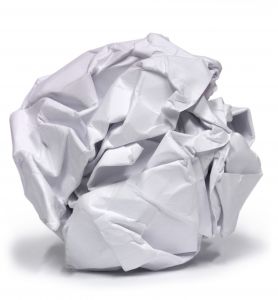 As part of the campus “Going Green” project Facilities Management will be placing e-waste bins at selected spots on campus. We encourage staff and students to use these bins for any non-asset e-waste.
As part of the campus “Going Green” project Facilities Management will be placing e-waste bins at selected spots on campus. We encourage staff and students to use these bins for any non-asset e-waste.
Two of these yellow bins (see example right) will also be located at IT. A bin will be placed at the IT HUB by the entrance and a second one will be placed at the IT Main building in Hammanshand Rd at the service entrance (facing IT the door on your right) Both bins will be just inside the buildings by the doors.
WHAT IS E-WASTE?
Electronic waste (e-waste) or Waste Electrical and Electronic Equipment (WEEE) are the terms used to describe old, end-of-life or discarded appliances using electricity. It includes computers, consumer electronics, batteries etc. which have been disposed of by their original users. More on e-waste.
We encourage all staff and students to use these bins for any non-asset e-waste. Bins will be serviced by Wasteplan and weekly inspections will be made by the university’s Wasteplan site supervisor to assess when a collection is needed.
For assistance and enquiries please email fmhelpdesk@sun.ac.za.



 Electronic waste (e-waste) or Waste Electrical and Electronic Equipment (WEEE) are the terms used to describe old, end-of-life or discarded appliances using electricity. It includes computers, consumer electronics, batteries etc. which have been disposed of by their original users.
Electronic waste (e-waste) or Waste Electrical and Electronic Equipment (WEEE) are the terms used to describe old, end-of-life or discarded appliances using electricity. It includes computers, consumer electronics, batteries etc. which have been disposed of by their original users. 
 Around 44% of old cellphones are lying around unused. Between 65% and 80% of the material content of a cellphone can be recycled or re-used. Now you are able to deposit old cellphones at cellphone outlets in South Africa for recycling.
Around 44% of old cellphones are lying around unused. Between 65% and 80% of the material content of a cellphone can be recycled or re-used. Now you are able to deposit old cellphones at cellphone outlets in South Africa for recycling.